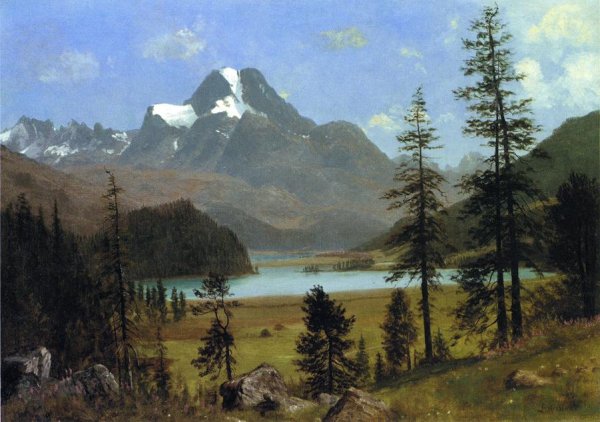Albert Bierstadt Biography In Details
Biography

Albert Bierstadt, was born in Solingen, Germany. He was only about two years old when his family moved from Germany to New Bedford in Massachusetts. In 1853 he returned to Germany to study in Dusseldorf, where he refined his technical abilities by painting Alpine landscapes. After he returned to America in 1857, he joined an overland survey expedition which allowed him to travel westward across the country.
Along the route, he took countless photographs and made sketches of the majestic mountain ranges and dramatic rock formations which became the studies for his massive canvasses painted in his New York studio. In December 1857 the Boston Athenaeum bought one of his works, The Portico of Octavia Rome, thus assuring his career.
Bierstadt always loved mountains, and he visited the White Mountains before he left for Dusseldorf, for his signature appears in the register on top of Mount Washington on August 11, 1852. He returned at various times from 1858 to 1886. Sometime in 1859 or 1860, Bierstadt visited New Hampshire with his brother, Edward, working in the then new medium of photography. He stayed at the Conway House in Conway, listing himself as "A. Bierstadt, New York," on September 13, 1862. He also spent considerable time at the Glen House in 1869 while at work on Emerald Pool, which he considered his finest work.
He exhibited at the Boston Athenaeum from 1859 to 1864, at the Brooklyn Art Association from 1861 to 1879, and at the Boston Art Club from 1873 to 1880. A member of the National Academy of Design from 1860 to 1902, he kept a studio in the 10th Street Studio Building, New York City from 1861 to 1879. He was a member of the Century Association from 1862 to 1902.
The artist's rugged, romanticized landscapes of the West, painted on a grand scale with an abundance of detail and dramatic lighting, captured the imagination of 19th-century art collectors and their interest catapulted Bierstadt to the top of the American art market. His paintings brought record prices and in his lifetime, Bierstadt enjoyed tremendous success and recognition.
Bierstadt became internationally renowned for his beautiful and enormous paintings of the newly accessible American west, and his works found their way into public and private collections at staggeringly high prices for his time. His popularity and wealth rose to tremendous heights only to fade as the interest in the Boston School and impressionism turned public taste away from his highly detailed landscapes suffused with golden light.
In 1867 he married, and he and his new bride went to London. There he met with Queen Victoria. His wife, Rosalie, needed to live in a warm climate for health reasons, so the couple lived in Nassau, and Bierstadt began to paint the tropics of Nassau as a result of his stays there.
He died suddenly in 1902 and people seemed to forget his work until the 1960's. People became more interested in preserving the national lands of the USA, and his paintings began to be shown again.(From flametree-studios)
Nonetheless, his paintings remain popular. He was a prolific artist, having completed over 500 (possibly as many as 4000) paintings during his lifetime, most of which have survived. Many are scattered through museums around the United States. Prints are available commercially for many. Original paintings themselves do occasionally come up for sale, at ever increasing prices.
Legacy

Because of Bierstadt's interest in mountain landscapes, Mount Bierstadt in Colorado is named in his honor. Another Colorado mountain was originally named Mount Rosa, after Bierstadt's wife, but it was later renamed Mount Evans after Colorado governor John Evans.
In 1998, the United States Postal Service issued a set of 20 commemorative stamps entitled "Four Centuries of American Art", one of which featured Albert Bierstadt's The Last of the Buffalo.
William Bliss Baker, another landscape artist, studied under Bierstadt.(From wikipedia)




